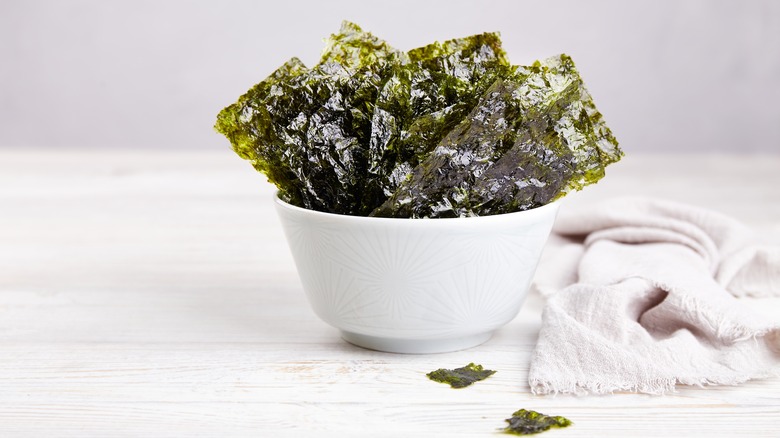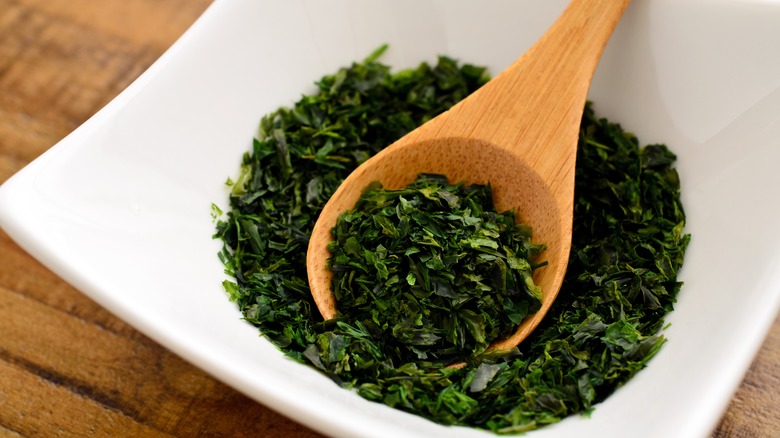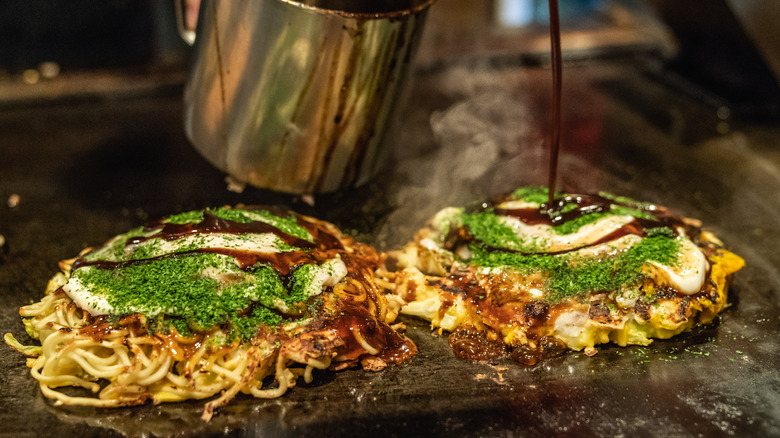Nori Vs. Aonori: What's The Difference?
Most cooks are already familiar with the vegetables growing in their garden, and some may have even learned how to forage, but let's not forget the vegetables of the sea. Seaweed, and all of its many different varieties, are a great culinary tool that shouldn't be left on the shelf. Edible seaweed may seem like the latest trendy superfood, but according to Bon Appétit, coastal countries have been incorporating seaweed into their diets for centuries. Communities in Britain, Ireland, Peru, and Norway have all found ways to make the most of their shoreline homes by cooking with seaweed. Sushi Sushi even says that there is evidence in harvesting seaweed dating back to the year 701.
There are many different types of seaweed that are harvested from around the globe. Just like there are a seemingly endless variety of apples, lettuces, or other vegetables on land, the same goes for the ocean. Most are some form of red, green, or brown algae. Two of the most common varieties used in Japan are called nori and aonori. To use each of these delicious varieties well though, it's important to know what separates one from the other.
Appearance
The most noticeable difference between these two seaweed varieties is their appearance. As Serious Eats notes, most people who are unfamiliar with seaweed have likely already had nori. It is the ubiquitous wrapper used in most sushi rolls, and the dark green sheets of nori have started popping up in more and more grocery stores in the U.S. in recent years.
According to Masterclass, Nori comes from a family of red algae known as pyropia. It is most often sold in whole sheets. Sushi Sushi says that this is accomplished by shredding the algae down into smaller flakes before pressing it into a square mold. The nori is then dried in special facilities. Restaurant Clicks points out that it will also typically be a dark green color, though depending on the drying process used it may also appear more black or brown as well.
Aonori on the other hand is a much brighter green color, per Masterclass. Aonori comes from a species of green algae, which is also called a green laver. Plus, instead of being sold in a single sheet, aonori is normally sold as flakes. These light green flakes can easily add a pop of color and salty flavor to a dish as a garnish, but won't be much help if you're trying to make sushi rolls.
Flavor and uses of nori and aonori
If these two seaweeds don't stand apart enough based on appearance alone, then the distinct flavors certainly put an ocean between them. Restaurant Clicks points out that nori tends to have a fairly light flavor, while Masterclass says that it can have a light smokiness to it, in some cases. For the most part though, nori tastes like the saltiness of the ocean, and this tends to make it a great first step into the world of edible seaweeds. It also makes it a light option for a low-carb wrap and won't interfere in the delicate balance of a good sushi roll.
100% Pure Japan says that aonori, despite its small flaked appearance, has quite a hefty flavor. Masterclass describes the aonori flavor as "robust and earthy." This serious flavor makes it great for seasoning mixes as well as garnishes on savory dishes. Japanese Cooking 101 says that aonori flakes are often sprinkled on the street food takoyaki, the noodle dish yakisoba, and an okonomiyaki pancake. 100% Pure Japan adds that aonori's flaked appearance also causes it to often be confused with another seaweed called aosa, which is also often sold powdered or flaked, and so the two are often used interchangeably. Thankfully, their flavors are also quite similar because they come from the same genus of algae.


